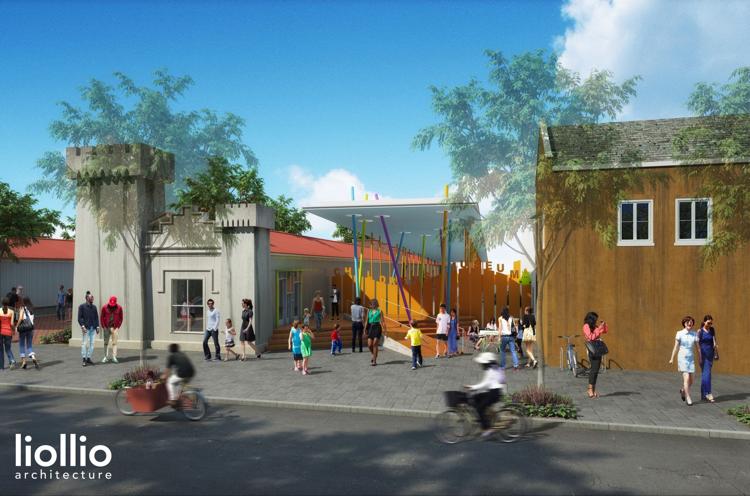The Children’s Museum of the Lowcountry asks its visitors — kids and caregivers alike — to use their imaginations. Now, with plans in hand for a $6.2 million makeover, it’s inviting the community to imagine something completely new at the downtown site.
With its “Make & Believe” campaign, the museum, which is housed in a narrow building stretching from Ann Street to John Street on the peninsula, has crafted plans to build an outdoor pavilion and overhaul its exhibits.
About $550,000 worth of improvements were already completed during a seven week renovation earlier this year. Those projects, which involved installing new heating and cooling systems, adding a ceiling and redoing the bathrooms, set the stage for the full makeover, said Nichole Myles, the museum’s executive director.
So far, donors have given about $2.1 million to the project. The museum needs to raise another $1 million before the end of the year and, preferably, within the next four to six months, to ensure they qualify for all $2.55 million they hope to receive in tax credits.
One of the most challenging aspects of developing the new plan was figuring out how best to utilize the museum’s long, narrow lot. The building that houses the museum was originally built as a train shed in 1859.
But that challenge became a kind of asset, Myles said. The unusual setup called for more creativity in planning.
Originally, the museum had hoped to build a new two-story building next to its existing structure, but the cost of building materials was too high, Myles said. The pavilion plans, “have the same aesthetic quality at a much lower cost.”
What’s now the museum’s art room will become the new entrance and lobby, directly facing Ann Street. The “play pavilion” will include three distinct exhibit areas, starting with an interactive area that mimics the activity at the Port of Charleston. Cargo comes in the form of plastic balls, which children help move from a truck to a crane to a boat.
Those plastic balls then make their way to the next area, “Lottawatta Island.” The water features in the museum now are a “perennial favorite” but “highly outdated,” Myles said.
In the new exhibit, precipitation would drip from a “rain cloud” overhead, and the balls from the port exhibit will be tossed into the water by “Mr. Octopop,” a top-hatted octopus, and shot back to the port by a bedazzled volcano.
The concept of connecting distinct exhibits is a relatively new idea in children’s museum design, Myles said.
“We’re trying to create this little bubble,” Myles said. “These exhibits are designed to wrap you in an experience rather than place you in it.”
Roto, an exhibit design firm from Dublin, Ohio, took a lot of its cues from a fall 2017 meeting with more than 100 community representatives, including business leaders, parents and educators.
From those sessions, they learned that parents wanted the grocery store area to stay. A new version would have Publix supermarket-branded carts, a child-size food truck and a musical tree.
Educators gave examples of material the museum could help their students learn, like the phases of the moon — a feature with exhibit designers incorporated into the earth- and space-themed “Earth and Beyond” exhibit.
Other planned exhibits include the “Shape Space,” a makerspace for kids, complete with tools and a 3-D printer. It would be the first certified early-childhood ‘Fab Lab’ in the Southeast, Myles said.
But the most unique exhibit, Myles said, may be “Don’t Touch the Floor,” a room inspired by the classic childhood game played in living rooms and on playgrounds. Using projections, the exhibit floor could appear to be lava, water, clouds or other settings as children navigate their way across it.
It was a way to have children solve a life-size engineering problem that gets them moving, communicating and problem solving, Myles said.
Myles described the exhibits’ designs as “incredibly intentional.”
“That’s part of the magic of children’s museums,” Myles said last Monday as lines of children in t-shirts and name tags streamed into the building. The museum is closed on Mondays but often uses those days to host large field trips.
About 7,200 children come through the museum on field trips every year, Myles said, and the museum gets about 130,000 total visitors annually. About 80 percent of those guests are from South Carolina, and the majority come from the tri-county area.
Though the planned renovations are extensive, Myles said it won’t be a “drawn-out process.” Construction on the pavilion would take about four months. The exhibits will likely be redone in phases.
“It’s going to be state-of-the-art,” said Kaky Grant, the president of the museum’s board. “We think Charleston deserves it.” (Credit: The Post & Courier)
For more information on Charleston SC and current real estate offerings, please contact THE BRENNAMAN GROUP: 843.345.6074 – bob@charlestonproperty.net – www.BrennamanGroup.com
